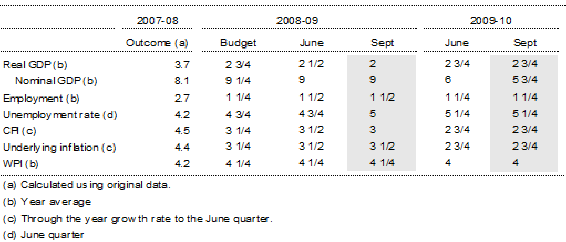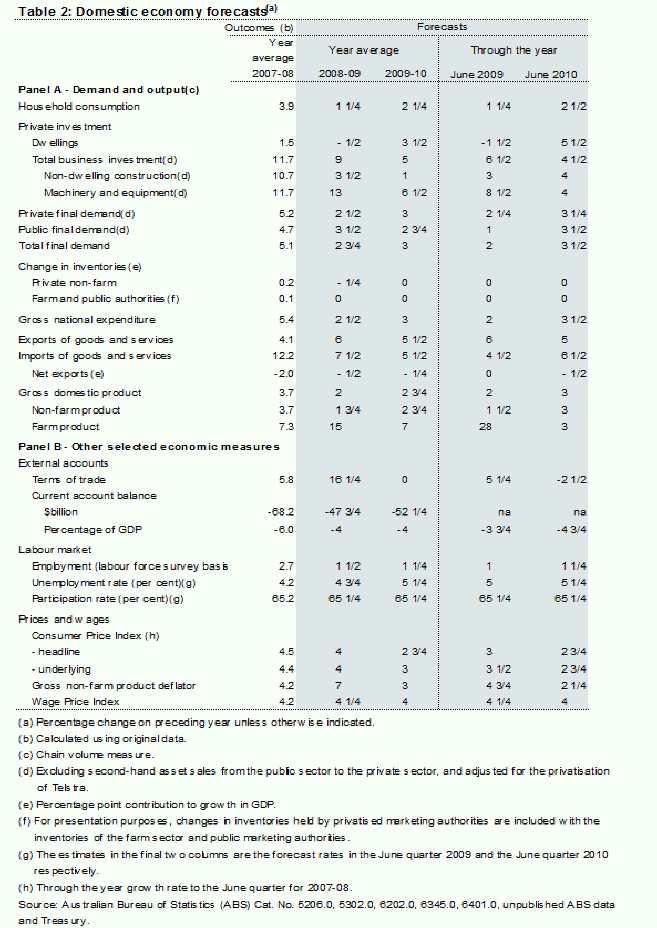Although both the Budget and June round forecasts implied some slowing in the Australian economy, recent data indicates that the downturn is likely to be deeper in the short-term than previously anticipated.
The outlook for household consumption and dwelling investment has deteriorated significantly, more than offsetting a stronger outlook for business investment and net exports. As a result, real GDP is now forecast to grow by 2 per cent in 2008-09, down from 2½ per cent forecast at June. In 2009-10, the outlook remains broadly unchanged, with GDP expected to grow by 2¾ per cent - a recovery but still below trend.
Our forecasts still represent a 'soft landing' in the face of considerable economic headwinds. The majority of the slowing is in the non-farm economy, with the farm sector still expected to rebound as at the June round. However, lower than expected rainfall in the critical month of August poses a downside risk.
These forecasts have been prepared against the backdrop of one of the most significant upheavals on global financial markets in recent history, as the fallout from the sub-prime crisis in the United States continues to unfold. Following the collapse of a number of large investment banks in the United States, the outlook for the global financial system has deteriorated significantly since June. While it is now clear that the collapse in confidence in the United States financial system is far more serious than previously thought, the ability of a planned bail-out to restore confidence has yet to be tested. As such, the impact of the crisis on economic growth in advanced and emerging economies remains very unclear, and the ensuing financial market volatility remains a considerable risk to the outlook.
The turmoil is flowing through to the Australian economy in our forecasts for household consumption, investment and the external sector. It has also been reflected in significant volatility in exchange rates and oil prices. The $US exchange rate, having traded close to parity in the middle of the year lost around 20 per cent in the month of September and had traded as low as 78c before recovering some ground. Oil prices have shown similar volatility, trading from a high of around $140 to levels below $100 in September.
This volatility has made the selection of appropriate assumptions to underpin the forecasts particularly difficult for this round. As such, oil prices and the $US exchange rate are assumed to be $US 106 and 84 cents respectively over the forecast period, around their current levels. The assumptions chosen represent a 25 per cent fall in $US oil prices, and a 12 per cent depreciation of the Australian dollar against the $US since June. These changes have significant effects on our forecasts, and the future path of both these aggregates represents a key area of uncertainty for the outlook.
Table 1: Key Domestic Forecasts - September compared with Budget and June informal

Source: ABS Cat. No. 5206.0, 6345.0, 6401.0, 6202.0 and Treasury.
Business investment is expected to remain strong, although this masks a divergence in expectations at a sectoral level. Mining investment is expected to remain strong, bolstered by a large amount of work already in the pipeline and a lower reliance on credit due to strong profits. In contrast, non-mining investment is expected to slow, hampered by a weaker outlook for the economy and the reduced availability of credit. In view of recent financial market developments, lack of availability fo credit represents a key downside risk to the outlook for business investment.
As the economy continues to slow, employment growth is forecast to ease further in 2008-09 and 2009-10. Following growth of 2.5 per cent through the year to June 2008, employment is forecast to slow to 1 per cent in the year to the June quarter 2009, before growing by 1¼ per cent to the June quarter 2010, below growth in the labour force. As such, the unemployment rate is expected to increase to around 5¼ per cent by end of the forecast horizon. The participation rate is expected to remain around its current level of 65¼ per cent over the forecast horizon, supported by still strong rates of skilled migration.
The decline in world oil prices since the June round, coupled with a slowing economy, is expected to help further ease inflationary pressures over the forecast horizon. Headline CPI is now expected to peak at 4¾ per cent through the year to the September quarter 2008, but to return within the target band sooner, growing by 3 per cent through the year to the June quarter 2009 and 2¾ per cent through the year to the June quarter 2010. Underlying inflation will take longer to ease, and is forecast to be 3½ per cent through the year to the June quarter 2009. The inflation forecasts are sensitive to assumptions about the exchange rate and oil prices. As such, volatility in these variables presents a degree of uncertainty around these forecasts.
The current account deficit (CAD), having peaked at 7 per cent of GDP in the March quarter 2008, is expected to narrow sharply, averaging 4 per cent of GDP in 2008-09 and 2009-10. While this is driven primarily by the sharp increase in non-rural commodity prices we have already seen, it is being bolstered by stronger growth in exports than previously expected as capacity comes on-line, and weaker growth in imports as the exchange rate and slowing domestic demand play their part. These small trade surpluses are expected to be partially offset by higher remittances of mining profits to foreign investors and rising net interest payments from a higher stock of foreign debt.
